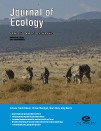Ver ítem
- xmlui.general.dspace_homeCentros Regionales y EEAsCentro Regional Patagonia NorteEEA BarilocheArtículos científicosxmlui.ArtifactBrowser.ItemViewer.trail
- Inicio
- Centros Regionales y EEAs
- Centro Regional Patagonia Norte
- EEA Bariloche
- Artículos científicos
- Ver ítem
Vegetation structure is as important as climate for explaining ecosystem function across Patagonian rangelands
Resumen
1. Drylands cover about 41% of Earth’s land surface, and 65% of their area supports domestic
livestock that depends on the above-ground net primary productivity (ANPP) of natural vegetation.
Thus, understanding how biotic and abiotic factors control ANPP and related ecosystem functions
can largely help to create more sustainable land-use practices in rangelands, particularly in the
context of ongoing global environmental change.
2. We used 311 sites
[ver mas...]
1. Drylands cover about 41% of Earth’s land surface, and 65% of their area supports domestic
livestock that depends on the above-ground net primary productivity (ANPP) of natural vegetation.
Thus, understanding how biotic and abiotic factors control ANPP and related ecosystem functions
can largely help to create more sustainable land-use practices in rangelands, particularly in the
context of ongoing global environmental change.
2. We used 311 sites across a broad natural gradient in Patagonian rangelands to evaluate the relative
importance of climate (temperature and precipitation) and vegetation structure (grass and shrub
cover, species richness) as drivers of ANPP, precipitation-use efficiency (PUE) and precipitation
marginal response (PMR).
3. Climatic variables explained 60%, 52% and 12% of the variation in grass cover, shrub cover and
species richness, respectively. Shrub cover increased in areas with warmer, drier and winter rainfall climates,
while the response observed for both grass cover and species richness was the opposite. Climate
and vegetation structure explained 70%, 60% and 29% of the variation in ANPP, PUE and PMR,
respectively. These three variables increased with increasing vegetation cover, particularly grass cover.
Species richness also increased with ANPP, PUE and PMR. ANPP increased, and PUE decreased with
increasing mean annual precipitation, whereas PMR increased with the proportion of precipitation falling
in spring–summer. Temperature had a strong negative effect on ANPP and PUE, and a positive
direct effect on PMR. Standardized total effects from structural equation modelling showed that vegetation
structure and climate had similar strengths as drivers of ecosystem functioning. Grass cover had
the highest total effect on ANPP (0.58), PUE (0.55) and PMR (0.41). Among the climatic variables,
mean annual precipitation had the strongest total effect on ANPP (0.51) and PUE ( 0.41), and the
proportion of the precipitation falling in spring–summer was the most influential on PMR (0.36).
4. Synthesis. Vegetation structure is as important as climate in shaping ecosystem functioning Patagonian
rangelands. Maintaining and enhancing vegetation cover and species richness, particularly in grasses,
could reduce the adverse effects of climate change on ecosystem functioning in these ecosystems
[Cerrar]

Autor
Gaitan, Juan Jose;
Oliva, Gabriel Esteban;
Bran, Donaldo Eduardo;
Maestre, Fernando Tomás;
Aguiar, Martín Roberto;
Jobbagy Gampel, Esteban Gabriel;
Buono, Gustavo Gabriel;
Ferrante, Daniela;
Nakamatsu, Viviana Beatriz;
Ciari, Georgina;
Salomone, Jorge Manuel;
Massara Paletto, Virginia;
Fuente
Journal of ecology 102 (6) : 1419-1428. (November 2014)
Fecha
2014-11
ISSN
1365-2745
Formato
pdf
Tipo de documento
artículo
Palabras Claves
Derechos de acceso
Abierto
 Excepto donde se diga explicitamente, este item se publica bajo la siguiente descripción: Creative Commons Attribution-NonCommercial-ShareAlike 2.5 Unported (CC BY-NC-SA 2.5)
Excepto donde se diga explicitamente, este item se publica bajo la siguiente descripción: Creative Commons Attribution-NonCommercial-ShareAlike 2.5 Unported (CC BY-NC-SA 2.5)


